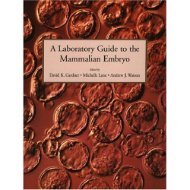- Page 1: METHODS IN MOLECULAR BIOLOGY 368 C
- Page 5: M E T H O D S I N M O L E C U L A R
- Page 8 and 9: © 2007 Humana Press Inc. 999 River
- Page 11 and 12: Contents Preface ..................
- Page 13 and 14: Contributors SUE ARMITAGE • Natio
- Page 15 and 16: Glossary of Specialized Terms Cell
- Page 17 and 18: 2 Stacey and Day However, such coll
- Page 19 and 20: 4 Stacey and Day bank prepared meet
- Page 21 and 22: 6 Table 2 Standards for Cell Bankin
- Page 23 and 24: 8 Stacey and Day Table 3 Examples o
- Page 25 and 26: 10 Table 4 Typical Storage and Tran
- Page 27 and 28: 12 Stacey and Day 5. Hebert, P. D.,
- Page 29: 14 Stacey and Day 38. Stacey, G. N.
- Page 33 and 34: Principles of Freeze-Drying 17 3. T
- Page 35 and 36: Principles of Freeze-Drying 19 Ofte
- Page 37 and 38: Principles of Freeze-Drying 21 form
- Page 39 and 40: Principles of Freeze-Drying 23 orie
- Page 41 and 42: Principles of Freeze-Drying 25 Fig.
- Page 43 and 44: Principles of Freeze-Drying 27 3. T
- Page 45 and 46: Principles of Freeze-Drying 29 may
- Page 47 and 48: Principles of Freeze-Drying 31 be c
- Page 49 and 50: Principles of Freeze-Drying 33 5. D
- Page 51 and 52: Principles of Freeze-Drying 35 auth
- Page 53 and 54: Principles of Freeze-Drying 37 32.
- Page 55 and 56: 3 Principles of Cryopreservation Da
- Page 57 and 58: Principles of Cryopreservation 41 f
- Page 59 and 60: Principles of Cryopreservation 43 F
- Page 61 and 62: Principles of Cryopreservation 45 F
- Page 63 and 64: Principles of Cryopreservation 47 F
- Page 65 and 66: Principles of Cryopreservation 49 K
- Page 67 and 68: Principles of Cryopreservation 51 v
- Page 69 and 70: Principles of Cryopreservation 53 F
- Page 71 and 72: Principles of Cryopreservation 55 a
- Page 73: Principles of Cryopreservation 57 2
- Page 76 and 77: 60 Matejtschuk Proteins were some o
- Page 78 and 79: 62 Matejtschuk others, such as mann
- Page 80 and 81:
64 Matejtschuk maintained typically
- Page 82 and 83:
66 Matejtschuk alone, and the probe
- Page 84 and 85:
68 Matejtschuk 8. The collapse temp
- Page 86 and 87:
70 Matejtschuk protein denaturation
- Page 88 and 89:
72 Matejtschuk 11. May, J. C., Whee
- Page 90 and 91:
74 Tindall storage in a fashion tha
- Page 92 and 93:
76 Tindall Fig. 2. The process of m
- Page 94 and 95:
78 Tindall Fig. 3. The process of h
- Page 96 and 97:
80 Tindall conditions is far too ex
- Page 98 and 99:
82 Tindall 3.2. Cryopreservation-Ba
- Page 100 and 101:
84 Tindall heat the culture and kil
- Page 102 and 103:
86 Tindall 2. Either wash the cells
- Page 104 and 105:
88 Tindall Fig. 7. Two freeze-drier
- Page 106 and 107:
90 Tindall stocks with that of the
- Page 108 and 109:
92 Tindall ampoule, without which i
- Page 110 and 111:
94 Tindall cultures by centrifugati
- Page 112 and 113:
96 Tindall three strains per alumin
- Page 115 and 116:
6 Freeze-Drying of Yeast Cultures C
- Page 117 and 118:
Freeze-Drying of Yeast Cultures 101
- Page 119 and 120:
Freeze-Drying of Yeast Cultures 103
- Page 121 and 122:
Freeze-Drying of Yeast Cultures 105
- Page 123:
Freeze-Drying of Yeast Cultures 107
- Page 126 and 127:
110 Bond However, some improvements
- Page 128 and 129:
112 Bond Fig. 1. Sealing polypropyl
- Page 130 and 131:
114 Bond 7. Transfer the cooled cry
- Page 132 and 133:
116 Bond If only a small number of
- Page 135 and 136:
8 Freeze-Drying Fungi Using a Shelf
- Page 137 and 138:
Freeze-Drying Fungi 121 3. Methods
- Page 139 and 140:
123 Table 2 Phase-Transition Data S
- Page 141:
Freeze-Drying Fungi 125 8. Back, J.
- Page 144 and 145:
128 Ryan and Smith of a preservatio
- Page 146 and 147:
130 Ryan and Smith fungi with some
- Page 148 and 149:
132 Ryan and Smith 2.3. Shelf Freez
- Page 150 and 151:
134 Ryan and Smith 14. Before stora
- Page 152 and 153:
136 Ryan and Smith 7. The phosphoru
- Page 154 and 155:
138 Ryan and Smith and -20°C (34)
- Page 156 and 157:
140 Ryan and Smith 36. Rey, L. R. (
- Page 158 and 159:
142 Day large numbers of cultures,
- Page 160 and 161:
144 Day Table 1 BG 11 Medium Stock
- Page 162 and 163:
146 Day b. Passive freezing system
- Page 164 and 165:
148 Day 10. Cyanobacteria and red a
- Page 166 and 167:
150 Day 27. For many algae, particu
- Page 169 and 170:
11 Cryopreservation of Plant Cell S
- Page 171 and 172:
Cryopreservation of Plant Cell Susp
- Page 173 and 174:
Cryopreservation of Plant Cell Susp
- Page 175 and 176:
Cryopreservation of Plant Cell Susp
- Page 177:
Cryopreservation of Plant Cell Susp
- Page 180 and 181:
164 Benson, Harding, and Johnston r
- Page 182 and 183:
166 Benson, Harding, and Johnston 3
- Page 184 and 185:
168 Benson, Harding, and Johnston t
- Page 186 and 187:
170 Benson, Harding, and Johnston d
- Page 188 and 189:
172 Benson, Harding, and Johnston 1
- Page 190 and 191:
174 Benson, Harding, and Johnston F
- Page 192 and 193:
176 Benson, Harding, and Johnston 3
- Page 194 and 195:
178 Benson, Harding, and Johnston 1
- Page 196 and 197:
180 Benson, Harding, and Johnston 3
- Page 198 and 199:
182 Benson, Harding, and Johnston 1
- Page 201 and 202:
13 Cryopreservation of Desiccation-
- Page 203 and 204:
Cryopreservation of Desiccation-Tol
- Page 205 and 206:
Cryopreservation of Desiccation-Tol
- Page 207 and 208:
Cryopreservation of Desiccation-Tol
- Page 209 and 210:
Cryopreservation of Desiccation-Tol
- Page 211 and 212:
Cryopreservation of Desiccation-Tol
- Page 213 and 214:
Cryopreservation of Desiccation-Tol
- Page 215 and 216:
Cryopreservation of Desiccation-Tol
- Page 217:
Cryopreservation of Desiccation-Tol
- Page 220 and 221:
204 Kopeika, Kopeika, and Zhang wid
- Page 222 and 223:
206 Kopeika, Kopeika, and Zhang a.
- Page 224 and 225:
208 Kopeika, Kopeika, and Zhang of
- Page 226 and 227:
210 Kopeika, Kopeika, and Zhang usu
- Page 228 and 229:
212 Kopeika, Kopeika, and Zhang of
- Page 230 and 231:
214 Kopeika, Kopeika, and Zhang Fig
- Page 232 and 233:
216 Kopeika, Kopeika, and Zhang P.,
- Page 235 and 236:
15 Cryopreservation of Avian Sperma
- Page 237 and 238:
Cryopreservation of Avian Spermatoz
- Page 239 and 240:
Cryopreservation of Avian Spermatoz
- Page 241:
Cryopreservation of Avian Spermatoz
- Page 244 and 245:
228 Morris Concomitant research int
- Page 246 and 247:
230 Morris 5. Count the cells over
- Page 248 and 249:
232 Morris shipped to other countri
- Page 250 and 251:
234 Morris When it is necessary to
- Page 252 and 253:
236 Morris 21. Stacey, G. N., Bolto
- Page 254 and 255:
238 Watt, Austin, and Armitage 1. I
- Page 256 and 257:
240 Watt, Austin, and Armitage 18.
- Page 258 and 259:
242 Watt, Austin, and Armitage usin
- Page 260 and 261:
244 Watt, Austin, and Armitage 3.1.
- Page 262 and 263:
246 Watt, Austin, and Armitage 17.
- Page 264 and 265:
248 Watt, Austin, and Armitage Ther
- Page 266 and 267:
250 Watt, Austin, and Armitage and
- Page 268 and 269:
252 Watt, Austin, and Armitage Fig.
- Page 270 and 271:
254 Watt, Austin, and Armitage 7. R
- Page 272 and 273:
256 Watt, Austin, and Armitage 12.
- Page 274 and 275:
258 Watt, Austin, and Armitage 10.
- Page 277 and 278:
18 Cryopreservation of Human Embryo
- Page 279 and 280:
Cryopreservation of hESCs 263 Never
- Page 281 and 282:
Cryopreservation of hESCs 265 2.2.
- Page 283 and 284:
Cryopreservation of hESCs 267 3.2.
- Page 285 and 286:
Cryopreservation of hESCs 269 13. C
- Page 287 and 288:
19 Cryopreservation of Primary Anim
- Page 289 and 290:
Primary Animal Cell Cultures 273 3.
- Page 291 and 292:
Primary Animal Cell Cultures 275 4.
- Page 293 and 294:
Primary Animal Cell Cultures 277 Fi
- Page 295 and 296:
Primary Animal Cell Cultures 279 me
- Page 297:
Primary Animal Cell Cultures 281 14
- Page 300 and 301:
284 Sputtek No. Cell Method Author
- Page 302 and 303:
286 Sputtek platelets (frozen in th
- Page 304 and 305:
288 Sputtek 7. Heat sealer. 8. Pate
- Page 306 and 307:
290 Sputtek 12. Storage of the froz
- Page 308 and 309:
292 Sputtek 14. Lift the reusable c
- Page 310 and 311:
294 Sputtek 5. Transfer the PC to a
- Page 312 and 313:
296 Sputtek 52. Place the bag of pl
- Page 314 and 315:
298 Sputtek 2. Generally, the cell
- Page 316 and 317:
300 Sputtek References 1. Sputtek,
- Page 319 and 320:
21 Cryopreservation of Mammalian Se
- Page 321 and 322:
Mammalian Semen 305 egg yolk in the
- Page 323 and 324:
Mammalian Semen 307 2. Materials 1.
- Page 325 and 326:
Mammalian Semen 309 5. Seminal flui
- Page 327:
Mammalian Semen 311 11. Wales, R. G
- Page 330 and 331:
314 Paynter and Fuller Fig. 1. Sche
- Page 332 and 333:
316 Paynter and Fuller ICSI, first
- Page 334 and 335:
318 Paynter and Fuller Fig. 2. Sche
- Page 336 and 337:
320 Paynter and Fuller 4. Pipet a m
- Page 338 and 339:
322 Paynter and Fuller 10. A piece
- Page 340 and 341:
324 Paynter and Fuller 14. Porcu, E
- Page 342 and 343:
326 Fuller and Paynter Fig. 1. (Con
- Page 344 and 345:
328 Fuller and Paynter The earliest
- Page 346 and 347:
330 Fuller and Paynter and water sh
- Page 348 and 349:
332 Fuller and Paynter 6. The next
- Page 350 and 351:
334 Fuller and Paynter temperature)
- Page 352 and 353:
336 Fuller and Paynter 5. The straw
- Page 354 and 355:
338 Fuller and Paynter bent through
- Page 357 and 358:
Index 341 Index A Algae, cryopreser
- Page 359 and 360:
Index 343 Dimethylsulfoxide (DMSO),
- Page 361 and 362:
Index 345 sample damage, chill dama
- Page 363:
Index 347 V Vapor pressure, lyophil




